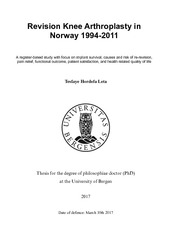| dc.description.abstract | Background and purpose: Globally, the number of both primary and revision knee arthroplasty surgeries performed each year is increasing. Revision knee arthroplasty surgery is more expensive, technically more difficult and complicated, and consumes more time and supplies than the primary knee arthroplasty surgery. Consequently, a reduced number of revisions would mean significant cost saving for society as well as reduced risk of pain, loss of function, and risk of complications for the patients. The overall aim of this thesis was to evaluate the outcomes of aseptic revision knee arthroplasties in Norway in terms of implant survival rate, causes and risk of rerevision, pain relief, functional outcome, patient satisfaction, and health related quality of life (HRQOL). Materials and Methods: All studies included in this thesis were based on aseptic revision knee arthroplasties reported to the Norwegian Arthroplasty Register (NAR) in the period 1994-2011 (Paper I-III) and additional information on patient reported outcomes (PROs) data in the period 1994-2005 (Paper II and III). The PROs data were on HRQOL (using EQ-5D), functional outcome, pain, and knee related quality of life (using the Knee Injury and Osteoarthritis Outcome Score (KOOS)), postoperative pain and satisfaction (using Visual Analogue Scale (VAS)), and on musculoskeletal comorbidity (using Charnley Category A, B, C). Kaplan-Meier and Coxregression were used to analyze prostheses survival rate and the risk of re-revision, whereas t-test and multiple linear regression were used to evaluate mean differences in the patient reported outcome measures (PROMs) scores between different revision procedures or treatment groups. Results: Paper I was based on 1016 primary Total Knee Arthroplasties (TKAs) revised to TKAs (rev-TKAs). The 10 years survival percentage was 78 %. Deep infection (28 %) and instability (26 %) were found to be the two most frequent causes of rerevision. Rev-TKAs with an exchange of the femoral or tibial component exclusively had a higher risk of re-revision (Relative Risk (RR) =1.7; p=0.02) compared to those with an exchange of the whole prosthesis. The risk of re-revision was double for men as compared to women (RR=2.0; p<0.001), and also increased for patients aged < 60 years compared to patients aged >70 years (RR=1.6; p=0.03). The use of bone impaction grafting had a positive effect on the survival rate whereas the use of long stem extensions, stabilization, bone cement, and patella resurfacing had no significant effect on the risk of re-revision. Survival rates were similar among prosthesis brands. In Paper II, the survival rate of TKAs revised with isolated secondary patella resurfacing (SPR) was assessed based on 308 knees (301 patients) of which 114 patient had PRO data. The 10 years survival of these revisions was 87 %. Pain alone (10 knees) was the most frequent cause of re-revision. The risk of re-revision was nearly 9 times higher for patients aged <60 years compared to patients aged >70 years (RR=8.6; p<0.001). The mean EQ-5D index score had significantly improved by 0.15 points following the revision TKA with isolated SPR. Nearly 70 % of patients who had preoperative severe pain in the EQ-5D pain/discomfort domain reported an improvement postoperatively. Overall, 63 % of patients that had reported PROs were satisfied with the SPR procedure. Males had a better result in mean ΔEQ-5D index score (i.e. postoperative minus preoperative EQ-5D index score). Older patients (>70 years) had better mean scores in the KOOS subscales compared to younger patients (≤ 70 years). Patients with unilateral knee joint problem (Charnley category ‘A’) had significantly better mean score in the KOOS subscales than patients with bilateral or multiple joint or general health problems. In Paper III, the survival rates of Unicompartmental Knee Arthroplasties (UKAs) to TKA (rev-UKAs) vs rev-TKA were assessed based on 768 rev-TKAs and 578 rev- UKAs, and clinical outcome was assessed based on PROs data from 150 of the 768 rev-TKAs and 127 of the 578 rev-UKAs. The technical difficulty of the surgical procedure for these two revision groups were assessed as a proxies of the length of operative time, and the need for bone impaction grafting, stem extensions, and/ or stabilization. The 10 years survival percentage of rev-UKAs vs rev-TKAs was 82 vs 81 %, respectively. The overall risk of a re-revision for rev-UKAs vs rev-TKAs was similar (RR= 1.3; p=0.2), nor did we find any differences in the mean PROM scores. For the elderly (> 70 years), however, the risk of a re-revision was double for rev-TKAs compared to the rev-UKAs (RR= 2.1; p=0.05). Loose tibia (28 vs 17 %), pain alone (21 vs 12 %), instability (19 vs 19 %), and deep infection (16 vs 31 %) were main causes of re-revision for rev-UKAs vs rev-TKAs, respectively. The observed differences in the proportion of reasons for re-revision were statistically significant only for the deep infection where the rev-TKAs were 2.2 times more frequently re-revised due to deep infection than the rev-UKAs (RR=2.2; p=0.03). The surgical procedure for rev-TKAs took longer time (mean=150 vs 114 minutes) and needed more stems (58 vs 19 %), bone impaction (24 vs 19 %), and stabilizing (27 vs 9 %) compared to rev-UKAs. Conclusions: The overall conclusion of this PhD study is that the long-term implant survival following aseptic revision knee arthroplasty in Norway in the period between 1994 and 2011 was satisfactory (range 78-87 % at 10 years), and a number of points were noted. Specifically: i) Complete TKA revisions had better implant survival rate than partial revisions. Thus, partial revisions should only be done after careful consideration in specific instances. Male gender and younger age (<60 years) were risk factors for rerevision. Patellar resurfacing, prosthesis brands, constrained implants, the use of stem extensions, and/or fixation method had no effect on the survival of rev-TKAs, whereas cases with bone impaction grafting had better results in terms of survival. Deep infection and instability were the most frequent causes of failure of rev-TKAs (Paper I). ii) For isolated SPR procedures pain and loosening were the main causes for re-revision. Young age (<60 years) was a risk factor for re-revision after these procedures. The mean HRQOL significantly improved following SPR. Isolated SPR procedure can provide a solution to patients with severe preoperative pain. Still, more than one-third of patients were dissatisfied with the outcomes of the SPR procedure. Male patients had a better post-revision improvement in mean EQ-5D index score, and patients with a unilateral joint problem (Charnley category ‘A’) had significantly better mean score in KOOS subscales than the other categories following revision TKA with isolated SPR (Paper II). iii) The overall outcomes of rev-UKAs and rev-TKAs in terms of implant survival rates, functional outcome, level of postoperative pain, patient satisfaction, and change on HRQOL status were similar. However, rev-TKAs seemed to be a technically more difficult surgical procedure, were re-revised more frequently due to deep infection, and had a double risk of re-revision for patient older than 70 years compared to that of rev-UKAs (Paper III). | en_US |

